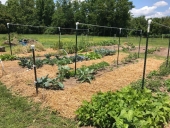Looks like someone didn't thresh their grain very thoroughly. It isn't difficult to kill young wheat, stirring or turning the mulch will do that.
IMO the difference between straw and hay is important, and often misunderstood.
Straw is senescent stalks of the cultivated annual grasses known as cereals. Sensecent means the stalks have transfered most of their minerals and
energy to the grain and then died. Straw is high carbon (mostly cellulose), low in minerals, decomposes slowly. It is regarded as a waste product in large commercial monoculture cereal farms. These farms produce nice clean straw with no weeds in it.
Sustainable organic cereal farms don't use herbicides so they usually have weeds at the seeding stage in with their straw. They also are often reluctant to give away their straw. They will
sell it only if they don't want it for their own uses (such as bedding animals or composting). In composting terms "brown".
Hay is grass (or grasses, herbs etc.) cut when green and full of life and dried. It is rich in minerals, relatively low in carbon. It decomposes fast. Mountain meadows can be cut every year or two with little or no manure or fertiliser, the wild herbs and flowers thrive, but the yields can be pretty low this way. Some hay is grown at higher yields commercially with fertilisers. But IMO buying this kind of hay is effectively buying fertiliser. In composting terms, hay is "green".
Haymaking is skilled labour/energy intensive and takes a lot of land. Hay is not a waste product. The amount of hay needed to permanantly maintain a mulch thick enough to suppress weeds is huge. I tried this method for several years. I estimate that for every square meter of garden you need at least 3-4 square meters of highly productive hay meadow to be devoted entirely to your garden. If the hay is from hay from a nice traditional low input wild flower meadow, probably more area is required. I used fresh cut grass. Hay is dried and has less volume, 3-4 square meters is a very conservative estimate. So vegetable yields from this kind of garden would have to be divided by 4 (at least). Energy (human and/or mechanical) required for the hay also needs to be considered in the equation, and makes this method less attractive.
Weeds did grow up through the hay if the mulch wasn't replenished faster than it decayed. I found 18inches of mulch would kill established grass and weeds, six inches would keep new weed seeds germinating.
I have in the past been given free grass clippings from golf courses and salvaged old spoiled haystacks destined to be burned or landfilled (where I live farmers cut rather more hay than they need, in case of a long winter, store surpluses for a year or two and then dispose of it), so some years there is lots of surplus spoiled hay, other years none. I know someone whose neighbour is cutting masses of
nettles and gives them away to use as mulch. But these are exceptional circumstances. Once you embark on a system of permanant mulch, you need a continuous supply of mulch. If you are surrounded by wasteful farmers, overusing fertilisers and throwing away materials they
should be returning to their own soil, it's good to use those materials.
IMO the best use for hay is feeding animals in winter. I have seen animals going hungry after all the locally available hay was bought and used to mulch footpaths.
Many gardeners use mulch temporarily in summer, and clear the ground in spring so the soil can warm up. This means they can use mulch when it is available, but aren't dependent on it.
Bill Mollison commented that sheet mulch was expensive, and seemed to view it as a way to establish perennials more than as a way to keep annual vegetables weed free.











































 1
1
































 1
1







